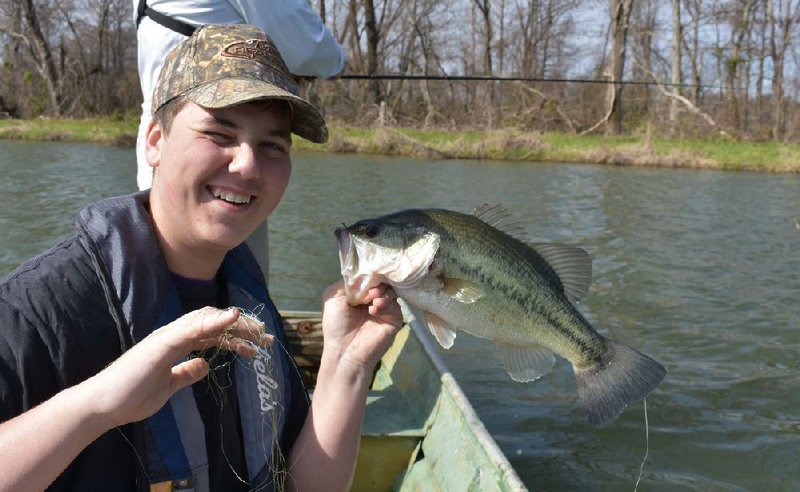For 20 glorious minutes, the bass fishing Sunday was excellent.
The occasion was a quickly arranged trip at a private lake with U.S. Magistrate Judge Joe Volpe of Little Rock and his son John Volpe. I don't know what it is about hunting and fishing with Volpe, but we have chronic coordination issues. Our 2018 goose hunting trip comes immediately to mind. Without belaboring whose fault the miscommunication was, suffice it to say that I arrived with about three minutes to spare.
The fishing trip itinerary was straightforward, with hardly any room for error. We were to meet at 10 a.m., which became 10:15 a.m. I knew where the place was, so that's where I went. At 10:15 a.m., no Volpes were in sight, so I started fishing from the bank. I caught a chunky bass on the first cast, and I caught them on every other cast for the next 20 minutes. I can't remember the last time I had a run like that.
At about 10:40 a.m., I went to the truck and checked my phone. There was a text and voice message from Volpe saying he and John were at the meeting place. Joe Volpe sounded irritated when I returned his call.
"I'm already here," I said cheerily. "I've caught 10 or 11 already. Right off the bank. There's nothing here but sloping sandy bottom, but they're everywhere!
"I'm sssssmoking them!" I added, twisting the knife.
Volpe's response is unprintable, but he and John arrived a few minutes later. We loaded all of our gear and a deep-cycle battery into a johnboat and started working the bank.
Because of the full moon, we should have been fishing at sunrise. I caught the last minutes of the early morning feed. Also, the Volpes' arrival roughly coincided with the onset of a high pressure front. Conditions went from being cool and calm to windy, with a blue sky and a bright, glaring sun. The wind made it very difficult for Joe Volpe to control the boat with an electric motor, so we were seldom in an ideal casting position.
The highlight of the day came early, while John Volpe dragged a blue plastic worm on the bottom. His line broke, but a fish inhaled the worm as John pulled the line hand over hand.
"I've got a fish on," John said.
"Oh, get over it," Joe Volpe retorted.
"I do! I swear!" John said. When it became clear that it was a sizable fish, John became positively giddy.
"What's the deal out here with big fish and broken line?" I asked. "Remember last summer when the same thing happened to me?"
"I forgot about that," Joe Volpe said, laughing. "Maybe you two cheapskates ought to change your line more often."
I activated the GoPro camera on my head to record John's fight, but the angle was wrong, and I missed most of the action. The bass weighed 3.5 pounds. It was John's only fish and the biggest fish of the day.
I caught all my fish from the bank with a 4-inch, pumpkin/red Bass Pro Shops swimbait with 10-pound test line on a Shimano Curado reel and a medium-action rod. I caught a couple of small bass from the boat and another small one with a Long A Bomber stickbait on a heavy-duty spinning rig, but the quality of the action had certainly downgraded from the photos Joe Volpe had texted me earlier in the week.
My tackle choices have evolved quite a bit over the years. Influenced by the bass fishing stars of the era, I used heavy tackle in the 1990s and early 2000s, epitomized by Falcon's Pool Cue rod. It was thick, brawny and unyielding, perfect for yanking bass out of thick cover. Of course, it's kind of silly to use that kind of gear to yank 1- and 2-pounders. It's unsporting.
One welcome improvement is the advent of fast reels. In the mid-1990s, only Daiwa made a reel with a 7:1 ratio. I introduced them to the bass fishing world in 1997 with an article I wrote for Bassmaster about Mitch Looper of Hackett and Chuck Justice, a bass fishing guide on McGee Creek Reservoir. Both are big bass specialists that used the fast Daiwa reels for jig fishing. Looper used it for swimming jigs. Hackett used it for the heaviest cover.
The 7:1 reel was a novelty that was perceived as being useful only for buzzbaits. It was unheard of to use them for jig fishing. Nowadays, 7:1 is about mid-range.
In the meantime, I discovered inshore saltwater fishing where the most accomplished guides use medium-action spinning reels to catch 30-pound-plus redfish and snook. A big largemouth bass is not remotely in the same league with those fish, and I learned that medium-duty spinning tackle is quite sufficient for wrestling trophy snook away from oyster and barnacle encrusted dock pilings that snap line on contact. It's all about using the right test line for the job and drag control.
While I still use a few baitcasting reels from the 1990s for special applications, there is no question that the most modern reels are remarkably better. They cast smoother, retrieve smoother than older models, and sophisticated braking systems greatly reduce backlash. Modern drags are outstanding, as is the quality of the newer ball bearings.
Fishing line is a lot better than it used to be, especially braided line. Also, anglers have developed or refined a lot of new knots that enable us to splice flourocarbon leaders to monofilament or braided backing.
None of it matters when fish won't bite.
Sports on 03/12/2020

